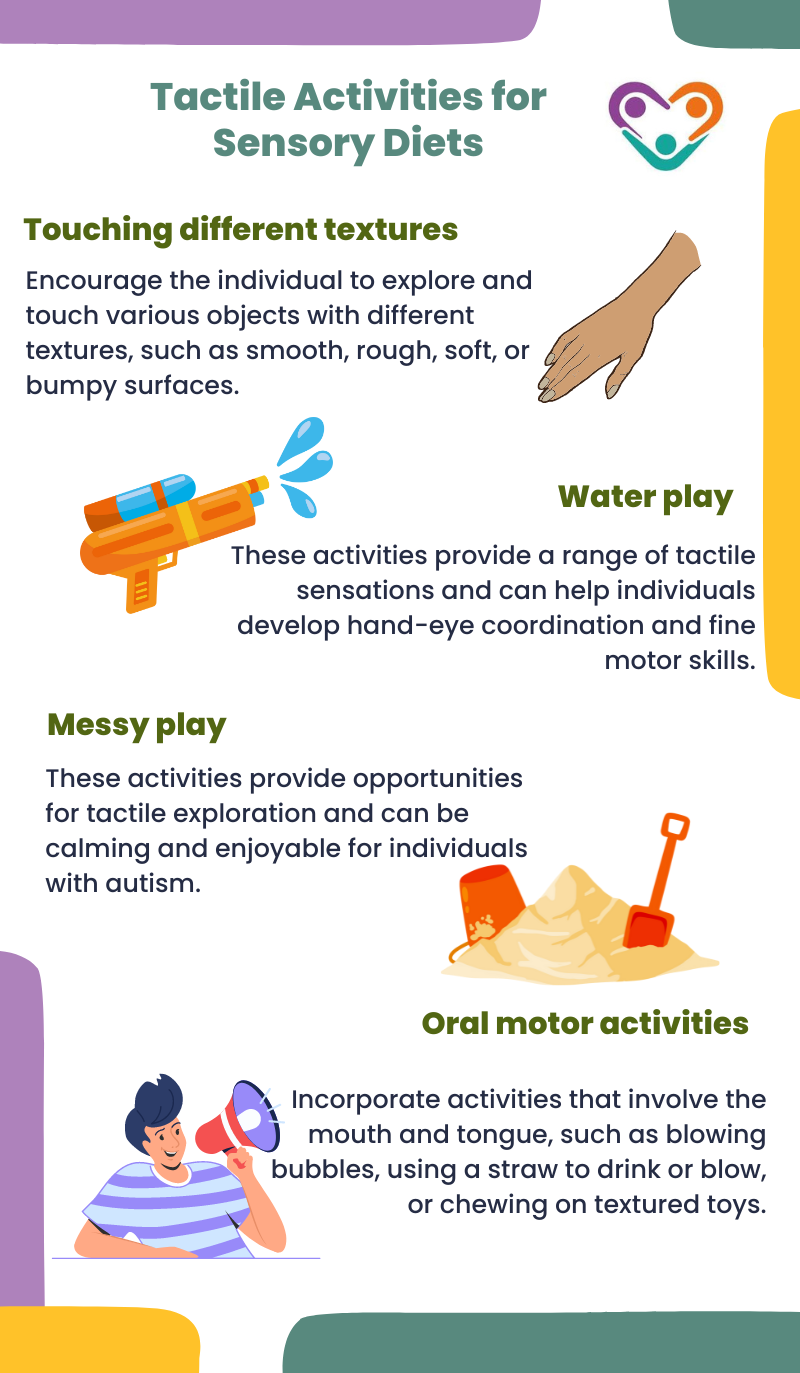Tactile sensory perception, also known as the sense of touch, plays a vital role in our daily lives. It allows us to experience and interpret different textures, temperatures, and sensations through our skin. From feeling the softness of a blanket to experiencing the warmth of the sun or the gentle touch of a loved one, our tactile sense helps us navigate and understand the world around us.
The tactile system consists of a complex network of nerves and receptors in our skin that detect and transmit touch sensations to the brain. It is a crucial part of our sensory system, enabling us to engage in various activities and interact with our environment. Tactile sensory perception allows us to recognize objects, ensure our safety, communicate with others, and build social connections.

Importance of Tactile Sensory Development
Tactile sensory development is particularly significant during the early stages of a child’s life. It begins from the moment they enter the world and encompasses a wide range of experiences and activities. These include early exploration, bonding and attachment, sensory learning, motor skills development, emotional expression, sensory stimulation, and exploration of their surroundings.
Individuals with autism, however, often experience sensory difficulties. Tactile sensory activities provide these individuals the opportunity to engage with different textures and stimuli in a controlled and supportive environment. These activities can also help these individuals with sensory difficulties regulate their responses to tactile sensations and develop a greater tolerance for different touch experiences.
These activities can be adapted to complement individuals’ curriculum and individualized education plans. By incorporating tactile sensory activities into daily routines and interventions, individuals with autism can enhance their sensory processing skills, improve motor coordination, promote cognitive growth, support emotional development, and foster social connections.
Tactile Sensory in Children
Some children with autism may experience tactile dysfunction, which can have a significant impact on their daily routines. It can manifest in different ways, such as hypersensitivity or hyposensitivity to touch, tactile discrimination issues, or problems with tactile sensory modulation. These challenges can affect how children interact with their environment and engage in everyday activities.
Children with tactile dysfunction may exhibit hypersensitivity, also known as tactile defensiveness, which can cause them to perceive harmless touch as threatening. On the other hand, some children may have a low response to touch sensations. This often leads to them seeking excessive touch sensations and engaging in behaviors like touching everything around them.
Recognizing the signs of tactile dysfunction is important for parents and caregivers. Overresponsive children may demonstrate characteristics like avoiding messy play and avoiding physical contact. Underresponsive children, on the other hand, may seem indifferent to touch sensations or demonstrate a lack of reaction to touch stimuli, affecting their engagement in daily activities.
Tactile Sensory Strategies
When it comes to addressing tactile sensory challenges in individuals with autism, there are various strategies that can be employed to help promote sensory development and improve sensory processing. Two key approaches in this regard are occupational therapy and sensory diet incorporation.
Occupational Therapy Approaches
Occupational therapists are trained professionals who specialize in helping individuals develop or regain the skills necessary for daily living activities. They provide a range of strategies and activities to help individuals better process tactile information and manage their symptoms.
In the context of autism, occupational therapists utilize various techniques to address tactile sensitivities and difficulties. These may include desensitization exercises, which gradually expose individuals to different textures and sensations to help them become more comfortable with touch.
Sensory Diet Incorporation
Another effective approach for autistic people with tactile sensory challenges is the incorporation of a sensory diet. A sensory diet consists of a personalized plan of strategies designed to meet an individual’s sensory needs throughout the day. These activities can include a variety of sensory experiences, including tactile stimulation.
These activities can be tailored and adapted to complement an individual’s curriculum and individualized education plan. By incorporating sensory diets into daily routines, individuals with autism can experience a more regulated sensory environment, which can positively impact their overall well-being and ability to engage in daily activities.
Tactile Sensory Activities
Tactile sensory activities are essential for individuals with autism as they can promote sensory development and overall well-being. These activities play a crucial role in sensory diets and fine motor skill-building programs, aiding in hand and finger awareness, attention, and fine motor planning.

Tactile Activities for Sensory Diets
Tactile sensory activities are often incorporated into sensory diets, which are personalized plans designed to address sensory needs and promote self-regulation. These activities can help individuals with autism engage their tactile system and develop sensory processing skills.
- Touching different textures: Encourage the individual to explore and touch various objects with different textures, such as smooth, rough, soft, or bumpy surfaces. This can be done using sensory bins filled with materials like rice, sand, or beans.
- Water play: Engage in water-based activities, such as playing with water tables, pouring water, or using water-filled sensory toys. These activities provide a range of tactile sensations and can help individuals develop hand-eye coordination and fine motor skills.
- Messy play: Engage in activities that involve materials like finger paints, playdough, or slime. These activities provide opportunities for tactile exploration and can be calming and enjoyable for individuals with autism.
- Oral motor activities: Incorporate activities that involve the mouth and tongue, such as blowing bubbles, using a straw to drink or blow, or chewing on textured toys. These activities can help individuals improve oral motor skills and sensory processing.
Role of Tactile Activities in Skill Development
Tactile sensory activities not only provide sensory input but also support the development of other skills, including gross motor and fine motor skills. Engaging in tactile activities can help improve the modulation of tactile sensations, further aiding in the overall sensory development of individuals with autism.
For example, tactile activities that involve manipulating objects or using fine motor skills, such as picking up small objects or threading beads, can enhance hand-eye coordination and fine motor control. These skills are important for tasks like writing, buttoning clothes, or using utensils.
Sensory Integration Therapy
Sensory integration therapy is a key approach used in occupational therapy to help individuals with autism regulate their tactile sensations and enhance sensory modulation. By incorporating specific techniques and activities, sensory integration therapy aims to improve sensory processing and integration in individuals with autism.
Regulating Tactile Sensations
One of the main objectives of sensory integration therapy is to assist individuals in regulating their tactile sensations. Occupational therapists utilize a range of techniques and activities to help individuals with autism develop better tolerance and processing of tactile stimuli.
Enhancing Sensory Modulation
Sensory modulation refers to the ability to appropriately respond to and regulate sensory input. Sensory integration therapy aims to enhance sensory modulation skills in individuals with autism. By engaging in specific activities, individuals can improve their ability to regulate and process sensory information.
- Proprioceptive activities: Proprioceptive activities involve deep pressure and joint compression to stimulate the proprioceptive system. These activities, such as pushing or pulling heavy objects, can help individuals with autism develop a better sense of body awareness and improve sensory modulation.
- Vestibular activities: Vestibular activities involve movements that stimulate the vestibular system, which is responsible for balance and spatial orientation. Engaging in activities like swinging, spinning, or rocking can help individuals with autism regulate their sensory responses and enhance sensory modulation.
- Tactile activities: Tactile activities, such as touching different textures, using tactile toys, or engaging in oral motor activities, can improve tactile processing and sensory modulation. These activities can help individuals develop better hand and finger awareness, attention, and fine motor planning.

The Takeaway
Tactile sensory perception is a crucial aspect of our daily lives, enabling us to experience and interpret various textures, temperatures, and sensations through our skin. This sense plays a vital role in activities ranging from recognizing objects to building social connections.
However, autistic individuals often face sensory difficulties, which can manifest as hypersensitivity or hyposensitivity. By understanding and addressing tactile sensory challenges, parents and caregivers can create an environment that allows individuals with autism to thrive.
If you’re seeking specialized ABA therapy in New Jersey, Indiana, Georgia, and New York, Golden Care offers comprehensive services tailored to meet the unique needs of each individual. Contact us to learn more or book a consultation today.
Sources:



